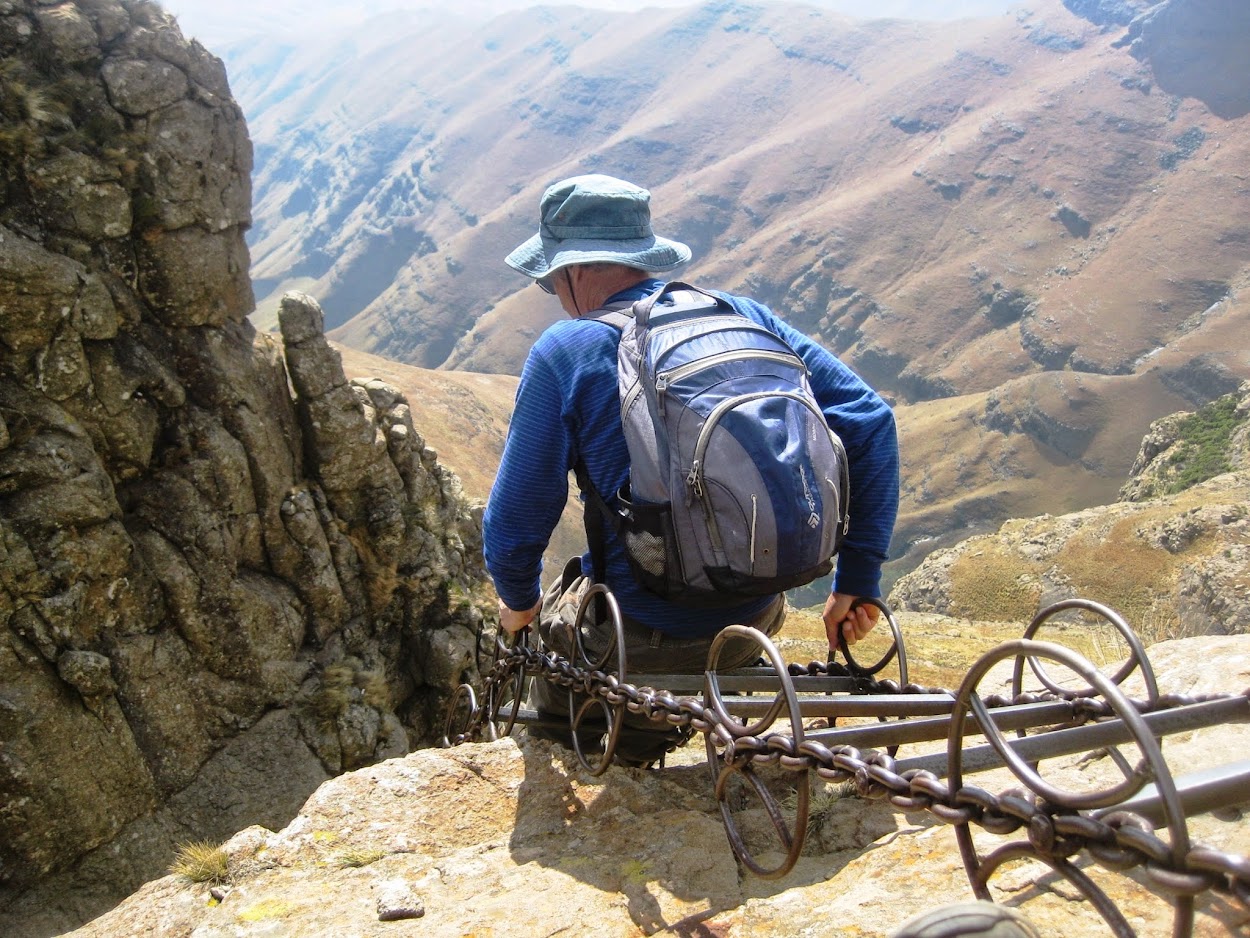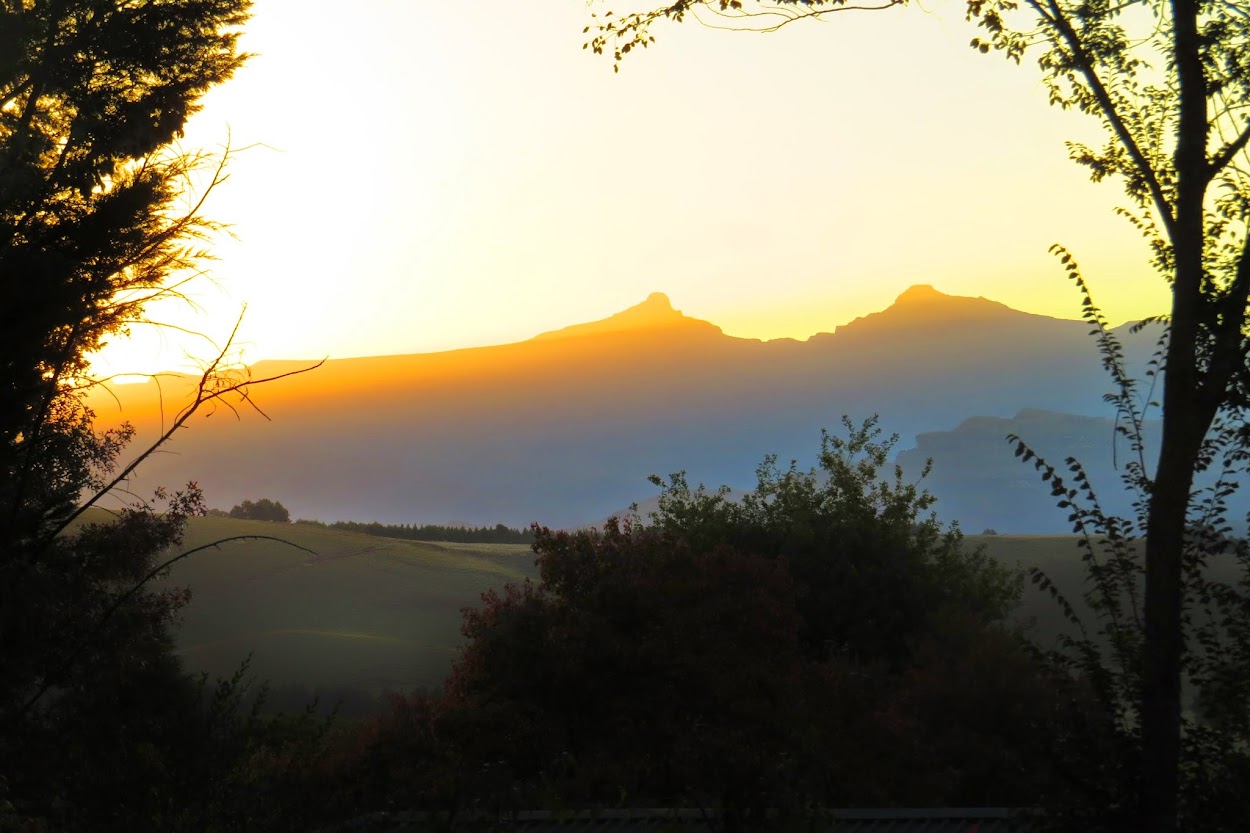 Jenni rests at the top of the Tugela Falls as the second highest waterfall in the world drips over.
Jenni rests at the top of the Tugela Falls as the second highest waterfall in the world drips over.
The peak of Mont-aux-Sources sits at 10,768 feet above sea level.
 A genuinely happy girl after a wonderful triumph, particularly, the inner struggle when facing
A genuinely happy girl after a wonderful triumph, particularly, the inner struggle when facing
the chain ladders.
 Peering over the edge of Tugela Falls but clouds blocking visuals, distorting the views.
See note to right to equalize the size of photos.
It turned
Peering over the edge of Tugela Falls but clouds blocking visuals, distorting the views.
See note to right to equalize the size of photos.
It turned out to be the final outing of Hike-about 17, also, the only repeat hike of this trip.
We
(bumped) three or four hikes to insert this one. When we climbed it some 15 months ago, we knew we’d
be back. It is a glorious hike; it is stunning. We would willingly make a double trans-Atlantic flight for
the experience. There are two massive waterfalls at the top, Eland and the Tugela and more exciting aspects, too.
The latter waterfall is the second highest in the world at 3,110 feet according to Wikipedia—there is a strong
opinion that Tugela is in fact the highest. Who cares? Nevertheless, it is ‘bloody’ high. In fact, it is impossible
to view the bottom of the cascading waters—too far down. The excitement does not end there. Two sets of chain
ladders are positioned immediately before the summit to enable the hiker to scale the vertical walls. As a
bonus,
horse rustlers apparently operate in the region and can be less than friendly to strangers encroaching on
‘their territory’. The stage is always set for a fantastic experience at the ‘Monti’.
 The first set of chain ladders below the summit.
The first set of chain ladders below the summit.
 One of many scenes of the interplay of clouds and mountains.
One of many scenes of the interplay of clouds and mountains.
 Editor approaches boldly, one wrung at a time, the second set of chains.
Editor approaches boldly, one wrung at a time, the second set of chains.
The Drakensberg Mountains do not allow motorists to ride over them at will. It usually means driving
long distances to circumvent these large basalt formations. Of course, hotels and lodges usually quote
‘as the crow flies’ mileage to prospective guests—a good tip for those wishing to visit this incredible
region. Mont-aux-Sources, more specifically, the Sentinel Hike is in the Northern Drakensberg, the High Berg.
We reserved a chalet at Witsieshoek which actually manages the trailhead. By this, we mean it charges a person
to enter the area which is literally, the end of the road. The said road ends under the massive Sentinel Peak,
situate in the Free State, on the Kwa-Zulu Natal border. Basically, Lesotho, Natal and the Free State are cozy
with each other in this area.
 A window next to the chains.
A window next to the chains.
 We walk past the Sentinel, circle and climb behind it to reach the mountain summit.
We walk past the Sentinel, circle and climb behind it to reach the mountain summit.
 'Gentleman' commences return down the upper-chain-ladder.
It was
'Gentleman' commences return down the upper-chain-ladder.
It was terrific to return and see the same staff members working at the hotel. A driver, now promoted
to waiter,
Ezekiel, did not recognize us, at first. After the hike, we sat in the lounge as we prepared
to do some work.
Samson, another employee joined us for a drink and we spent time swopping hiking
experiences of the Drakensberg. As we looked through some past photographs, one of
Ezekiel and the writer
popped onto the screen. It was hard to tell if Ezekiel’s face went red. All we can say is he’s a fine gentleman.
We met a professional photographer,
Doug Morton, in Himeville, the stop before. We were fortunate to
hear some of his experiences and see a few of his fine works. He mentioned, when he heard we were
heading north, that a storm was moving up from the Cape. A day later, when we arrived in Witsieshoek,
the clouds were heavy and looked ominous. The night before the hike, we could see no further than ten feet
in front of us. The following morning, the day of the hike, until 9:30am, visibility was about twenty feet.
It looked as if the storm was going to beat us. We pushed ahead, keeping an eye on the sky when not looking
at the path. The sun struggled for a while and then broke through the clouds. Thereafter, we received a
treat supreme as we witnessed our favorite scenes—blue sky above, thick clouds below and mountains partly
protruding through the clouds. It was a delight. The day could not have been better.
 Dwarfed by the action in the sky.
Dwarfed by the action in the sky.
 Mountain art of the Drakensberg.
Mountain art of the Drakensberg.
 Bringing up the 'rear'.
It’s almost
Bringing up the 'rear'.
It’s almost embarrassing to let you know how many pictures we took. Suffice to say, our cameras
were so heavy with pictures, we barely managed to carry them back. The highlight of the day, maybe the
trip, was our time at the chain ladders. On our previous visit, the editor got a little nervous and
decided to wait at the bottom. This time, she went up and down like a
pro. In fact, many prefer to go
via a gulley or at least, one leg of the trip using the gulley route. Jen looked at those chains, knew
that it’s not good to stare and moved up like a stalwart. The thing is that the longer it takes to commit to
commencing, the less chance one has of completing the hurdle. Well done, editor. (This
sweetness is
part of an ongoing strategy to gain her favor).
 We've looked at clouds from both sides now...
We've looked at clouds from both sides now...
 Seeking the bottom of the 'bottomless' falls, looking into the abyss.
The only negative
Seeking the bottom of the 'bottomless' falls, looking into the abyss.
The only negative, and that wasn’t even an issue, is that the two massive waterfalls were almost dry.
Sad but true. They tell us if there is no snow or rain, then there is no waterfall. It seems logical
and so we did not feel too bad. When we gazed over the top of the Tugela, we thought of the poor drops of
water making the journey down that cliff. What a fall! We have a theory that water flowing over the cliff
of the Tugela Falls actually expands. In other words, for every gallon that leaves the top, a little more
than a gallon reaches the bottom. ‘Nonsense’, you might exclaim. Follow us here. Imagine it arriving at the
cliff edge and as it peers over, each droplet of water that is, catches a fright. What is the natural reaction?
It ‘wets’ itself. Hence, more water. Okay, it’s a theory but bloody scary standing there looking over.
 No matter at what angle we looked down the Tugela Falls, we could not see the bottom or
No matter at what angle we looked down the Tugela Falls, we could not see the bottom or
much water either although we were at the source of the river of the same name. It's an incredible feeling
being 'sandwiched' between sky and clouds with surrounding mountains prominent.
 The sun broke through and hit the right spot as we gazed downwards.
The sun broke through and hit the right spot as we gazed downwards.
The following day, expecting the advent of winter, we awoke to find ideal weather—there wasn’t a cloud
in the sky. We have learned never to predict the weather—you take what it gives and work within it.
We try not be intimidated by the weather as it often changes when least expected. One has to be optimistic.
Cheers,
Jenni and Jeffrey
 Final picture as we go 'over the top', on the way down.
Final picture as we go 'over the top', on the way down.
































































